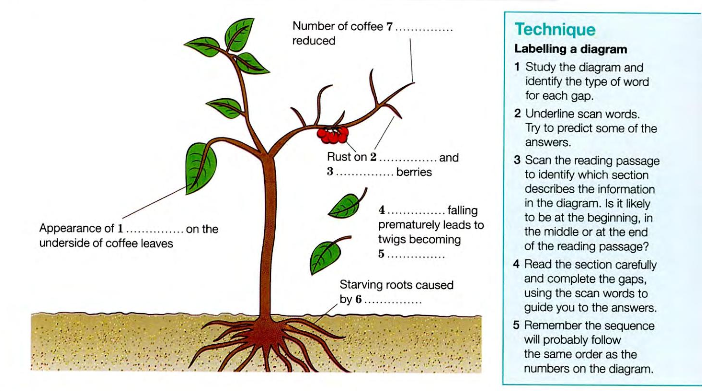ĐỀ THI IELTS READING CUỐI KHÓA
READING PASSAGE 1
You should spend about 20 minutes on Questions 1-12, which are based on Reading Passage 1 below.
Coffee rust
Why do the British drink so much tea? The answer to this question can be traced back, unexpectedly, to a humble fungus, hemileia vastatrix, which attacks the leaves of coffee plants causing a disease popularly known as coffee rust. The appearance of this disease was first reported in the British colony of Ceylon (now Sri Lanka) in 1867. Over the next twenty years, coffee production in Asia and Africa was virtually wiped out Following a period of severe to economic and social upheaval, planters in British colonies shifted to planting tea, and the British were gradually transformed into a nation of tea drinkers.
Under British rule, the island of Ceylon was stripped of its forests to turn over every available acre to coffee production. By the 1870s, Ceylon was exporting nearly 100 million pounds of coffee a year; much of it to England. This empire, however, was swiftly devastated by the arrival of the coffee rust fungus. The rust organism can be recognized by the presence of yellowish powdery lesions on the undersides of the leaves of the coffee plant. Occasionally, green shoots and even the green coffee berries can be infected. The infected leaves drop prematurely, leaving long expanses of bare twigs. This defoliation causes shoots and roots to starve and consequently to die back, reducing the number of nodes on which coffee can be produced the following season.
The rust fungus is dispersed by both wind and rain. By observing the patterns of infection on individual leaves, it can be deduced that splashing rain is the most important means of local, or short-range dispersal. Dispersal over wider areas is primarily by wind, although insects such as flies and wasps may also play a small part How the fungus first made its way from its native Ethiopia to Ceylon is unknown, but human intervention seems to be the only plausible explanation. Insects as carriers can be ruled out, and it is doubtful whether the fungus could have been blown so far. The coffee growers probably hoped at first that the disease would disappear as quickly and unaccountably as it had begun. By 1879, however, it was clear that it was not going away, and the Ceylon government made an appeal for someone to be sent to help. The British government responded by sending Harry Marshall Ward, whose brief was to investigate the coffee rust phenomenon and hopefully come up with a cure.
Ward recommended that to effectively protect the plant from invasion, the leaves should be treated with a coating of fungicide (lime-sulfur). Unfortunately; in the case of the Ceylon plantations, the rust epidemic was too well established for this prcitective measure to save the coffee trees. He also pointed out the risks of intensive monoculture. The continuous planting of coffee trees over the island, without even the benefit of windbreaks, had created a perfect environment for a fungus epidemic to spread. Despite Ward’s warning, when the coffee trees were replaced with tea bushes, they were planted at the same density. It was only by good fortune that no similar fungus arrived to invade the tea bushes and that improved fungicides were soon available to protect the crop.
With the destruction of the coffee plantations in Ceylon and subsequent arrival of coffee rust in Java and Sumatra, the world’s coffee production shifted to the Americas. Plantations were swiftly established in the tropical highlands of Brazil, Colombia and Central America. Brazil soon became the world’s major coffee supplier, closely followed by Colombia. Coffee rust was successfully excluded from the Americas for over 100 years by careful quarantine measures. However, in 1970, the fungus was discovered in Brazil, again probably brought in accidentally by humans. Once the barrier of the oceans had been breached, wind dispersal came into play. Infected trees were isolated by creating an 80 km coffeeless ‘safety zone’ around the infected area, but within eighteen months the rust had jumped the gap in the direction of the prevailing winds. Today, the fungus has spread throughout all the coffee-growing areas, including Colombia and the countries of Central America Fungicide applications are now part of the routine production practices on coffee plantations, despite the expense for small growers. Good cultural management taking into account the density of planting and the climate, is also paramount. Rust-resistant strains of coffee have also been developed but the crop is of poorer quality. Unless a truly rust-resistant variety with more desirable genetic traits can be produced, coffee rust will have to be managed as a continuous epidemic on a perennial crop.
READING PASSAGE 2
You should spend about 20 minutes on Questions 13-25, which are based on Reading Passage 2 below.
A
Even the Greeks coulcht’t agree about it Was music a source of order and proportion in society, regulating its innate chaos in ways similar to the disciplines of geometry and architecture? Or did its ability to express passionate emotions beyond the reach of words create the potential for disorder and anarchy? Compare the behaviour of an audience listening to classical string quartets with headbangers at a rave, and the age old conflict between Apollo and Dionysus is made manifest all over again in our own time.
B
Shakespeare, though, came clean. For him, ‘the man who bath no music in himself, Nor is not mov’d with concord of sweet sounds, Is fit for treasons, stratagems and spoils; The motions of his spirit are dull as night …’ Throughout his plays, Shakespeare perceives music as a healing force, an art whose practice makes man whole.
C
Yet, despite the growth of the science of music therapy within the last two centuries, and despite the huge weight of books published on the miraculous `Mozart effect’, our schools and colleges have fallen strangely silent The so-called `Mozart effect’ presents anecdotal and statistical evidence for advances in both social and academic skills in those children exposed in their formative years to the music of Mozart. But, in an age obsessed by pragmatism and by short-term vocational learning, music has been marginalized in both primary and secondary education. Compared with the holy trinity of reading, writing and arithmetic, music is regarded as an unimportant pastime. As a result, children are leaving school not only totally ignorant of their own musical heritage, but lacking in social, physical and mental skills which musical performance can uniquely promote.
D
Haying an instrument requires a degree of concentration and coordination which brings into play a plethora of mental and physical skills which are being eroded in our push-button world. Socialization and teamwork are also involved. Schools with wind bands, string ensembles, jazz groups and orchestras are right up there at the top of the league tables. In excelling in musical activity, the students’ performance in many other fields of learning is refocused and radically improved.
E
There are medical aspects too. Long before British primary schools discovered the recorder — that most basic of all modem woodwind instruments — Australian Aborigines had developed the didgeridoo. Like the clarinet and the flute, this haunting and beautiful instrument helped to overcome both upper and lower respiratory tract problems and encouraged better sleep. In playing a wind instrument, abdominal muscles are used to support the breathing system. And these are the very muscles which come into play when an asthmatic is experiencing an attack.
F
But what of those individuals and schools which simply cannot afford a musical instrument? What of those institutions where not a single member of staff can read music? This is where the human being’s most primitive form of music-making comes into its own. Singing is free. Everyone possesses a voice. And, with it, the body expresses itself in the most fundamental and organic way.
G
The Hungarian composer Zoltan Kodaly knew this, and developed his own system of training ear and voice within a simple yet comprehensive system of body language. Today, an organization called The Voices Foundation adapts and applies Kodaly’s methods, aiming to give children back their singing voices, and to make our schools ring with musicmaking once again. Their advisors and teachers have already achieved extraordinary turn-around effects the length and breadth of Britain and in schools in the troubled areas of South Africa.
H
Important work is currently being done in Finland, Israel and the United States on pre-school, even prebirth, musical education. Music in the womb is very much part of the life of the unbom figure citizens of Finland. And one has only to look at the educational standards, health records and professional musical activity in this small nation to see what dividends music in education pays from the earliest days of human life.
I
Mozart has been celebrated in his anniversary years of 1991 and again in 2006. By the time of the next Mozart-Year, shall we have allowed music to conjure a better society for us all? Or, relegated to the ranks of mere entertainment, will music be eroded of its unique power to heal and to make whole?
|
Bạn sẽ làm một đề IELTS Reading mini theo tài liệu chuẩn của bộ đề thi IELTS thực tế. Hướng dẫn:
|


